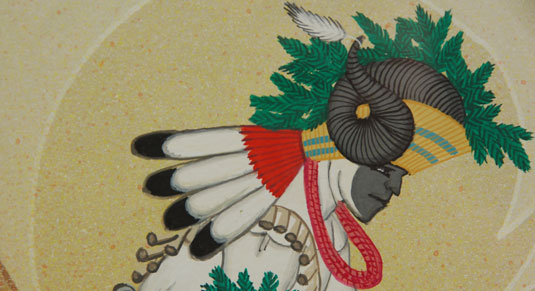Tewa Pueblo Ram Dancer Painting [SOLD]
+ Add to my watchlist Forward to Friend
- Category: Paintings
- Origin: Santa Clara Pueblo, Kha'p'oo Owinge
- Medium: Casein
- Size:
7” x 4-3/4” image;
15-1/8” x 12-1/2” framed - Item # C3699B SOLD
Special Value Offer: We have been authorized to offer this at a 30% price reduction from the original price of $3500 to a new price of $2450.
Animal Dances are performed during the winter when game animals are needed for food. The primary purpose is the attraction of animals to the village and for the increase in population of all animals. Dancers do not wear masks, as Katsinas do, but wear headdresses representing the animal being performed. Deer, buffalo, antelope, elk, and mountain sheep may all be represented in a single dance.
 Every item of the dance attire has a special significance. Spruce or fir twigs symbolize longevity and everlasting life. Men wear moccasins ornamented with black and white skunk fir to repel evil spirits from the feet of the dancers. Their kilts and sashes are decorated with sacred symbols in colored embroidery or brocade. The long flowing tassels of the sash represent the gentle falling rain. Pablita Velarde (1918-2006) Tse Tsan - Golden Dawn was well familiar with dance costume details and she was careful to portray dancers with accurate clothing. Her paintings are ethnographically important as well as artistically important. She has provided us with a detailed representation of pueblo dancers of her time.
Every item of the dance attire has a special significance. Spruce or fir twigs symbolize longevity and everlasting life. Men wear moccasins ornamented with black and white skunk fir to repel evil spirits from the feet of the dancers. Their kilts and sashes are decorated with sacred symbols in colored embroidery or brocade. The long flowing tassels of the sash represent the gentle falling rain. Pablita Velarde (1918-2006) Tse Tsan - Golden Dawn was well familiar with dance costume details and she was careful to portray dancers with accurate clothing. Her paintings are ethnographically important as well as artistically important. She has provided us with a detailed representation of pueblo dancers of her time.
Pueblo dances are a lure for visitors to the Southwest. One must remember that these are not performed to entertain the visitors but are performed because they are a part of a religious ceremony. The Pueblo Indian feels he is an important part of nature and the universe and that he must be in balance with nature and the universe. Ceremonial dances are part of achieving that balance. Such dances always have a purpose, a function, whether it be for rain, snow, game animals, crops or other good things in life.
This painting of a Mountain Sheep or Ram Dancer is signed in lower left but not dated. From the style of geometric design and mottled background imagery, it is probably from the decade of the 1990s.
Condition: The Tewa Pueblo Ram Dancer Painting appears to be in original excellent condition. It is framed with acid-free materials and has UV protective glass.
Recommended Reading: American Indian Paintings of the Southwest and Plains Areas by Dorothy Dunn
Provenance: from the collection of a Texas family

- Category: Paintings
- Origin: Santa Clara Pueblo, Kha'p'oo Owinge
- Medium: Casein
- Size:
7” x 4-3/4” image;
15-1/8” x 12-1/2” framed - Item # C3699B SOLD



